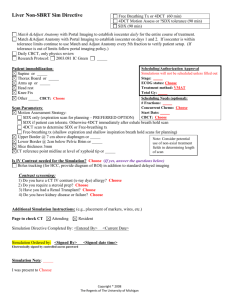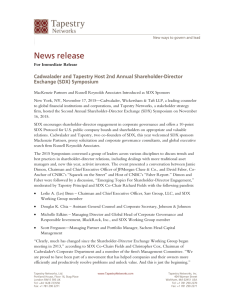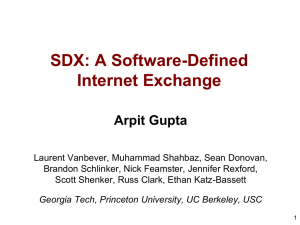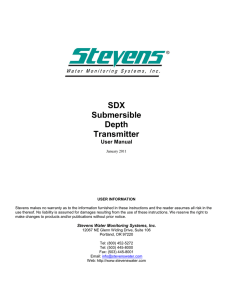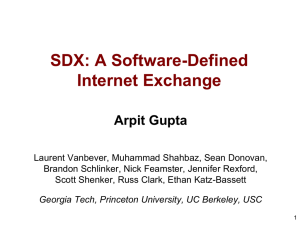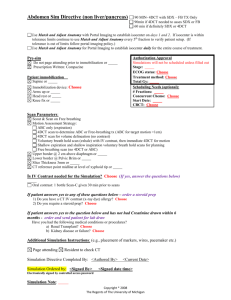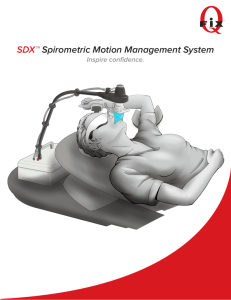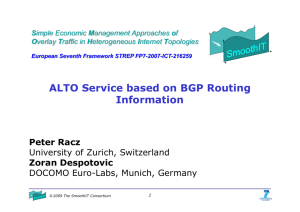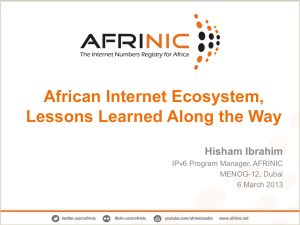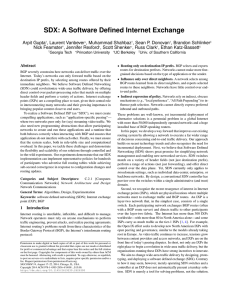SDX: Software-Defined Internet Exchange Points: Where We've
advertisement
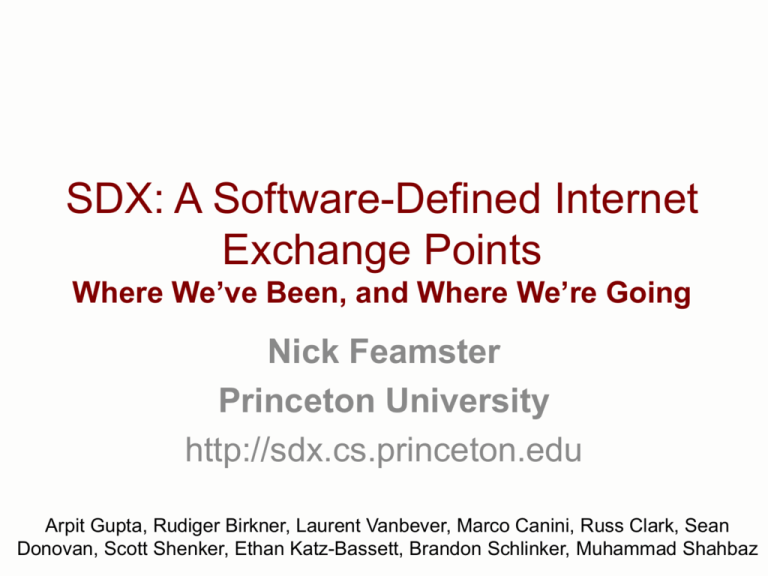
SDX: A Software-Defined Internet Exchange Points Where We’ve Been, and Where We’re Going Nick Feamster Princeton University http://sdx.cs.princeton.edu Arpit Gupta, Rudiger Birkner, Laurent Vanbever, Marco Canini, Russ Clark, Sean Donovan, Scott Shenker, Ethan Katz-Bassett, Brandon Schlinker, Muhammad Shahbaz Software Defined Networking • Changing how we design & manage networks – Data centers, backbones, enterprises, … • But, so far, mostly inside these networks – Network virtualization, traffic engineering, … • In this talk: – Fundamentally change interdomain traffic delivery – Starting at the boundaries between domains 2 Interdomain Routing is Not Flexible Enough! • Routing only on destination IP address blocks (No customization of routes by application or sender) • Can only influence immediate neighbors (No ability to affect path selection remotely) • Indirect control over packet forwarding (Indirect mechanisms to influence path selection) • Enables only basic packet forwarding (Difficult to introduce new in-network services) 3 Valuable Wide-Area Services • Application-specific peering – Route video traffic one way, and non-video another • Blocking denial-of-service traffic – Dropping unwanted traffic further upstream • Server load balancing – Directing client requests to different data centers • Steering through network functions – Transcoders, scrubbers, caches, crypto, … • Inbound traffic engineering – Splitting incoming traffic over multiple peering links 4 Enter Software-Defined Networking • Match packets on multiple header fields (not just destination IP address) • Control entire networks with one program (not just immediate neighbors) • Direct control over packet handling (not indirectly via routing protocol arcana) • Perform a variety of actions on packets (beyond basic packet forwarding) 5 Deploy SDN at Internet Exchanges • Leverage: SDN deployment even at single IXP can benefit tens to hundreds of providers – Without providers deploying new equipment! • Innovation hotbed: Incentives to innovate, as IXPs on front line of peering disputes • Growing in numbers: – 350-400 IXPs – ~100 new IXPs established in past few years 6 “SDX: A Software-Defined Exchange Point” (SIGCOMM 2014) Arpit Gupta, Nick Feamster, Laurent Vanbever, Muhammad Shahbaz, Sean Donovan, Brandon Schlinker, Scott Shenker, Russ Clark, Ethan Katz-Bassett “An Industrial-scale Software Defined Internet Exchange Point” (NSDI 2016) Arpit Gupta, Robert MacDavid, Rudiger Birkner, Marco Canini, Nick Feamster, Jennifer Rexford, Laurent Vanbever 7 Conventional IXPs Route Server BGP Session IXP Switching Fabric AS A Router AS B Router AS C Router 8 SDX = SDN + IXP SDX Controller SDX BGP Session SDN Switch AS A Router AS B Router AS C Router 9 SDX Architecture BGP Updates ARP Requests Central Services Participant Controller BGP Relay BGP Handler ARP Relay RIBs Update Handler IXP Controller Policy Compression Library Fabric Manager ARP Handler IXP Fabric Forwarding Table Entries 10 Use Case: Prevent DDoS Attacks Attacker AS1 can remotely block attack traffic at SDX(es) SDX 1 AS 2 AS 1 AS 3 SDX 2 Victim 11 SDX-based DDoS protection vs. Traditional Defenses/Blackholing • Remote influence Physical connectivity to SDX not required • More specific Drop rules based on multiple header fields, source address, destination address, port number … • Coordinated Drop rules can be coordinated across multiple IXPs 12 Inbound Traffic Engineering SDX Controller SDX AS A Router C1 C2 10.0.0.0/8 AS B Router AS C Routers 13 Inbound Traffic Engineering Incoming Data C1 C2 AS A Router AS B Router 10.0.0.0/8 AS C Routers Incoming Traffic dstport = 80 Out Port C1 Using BGP Using SDX 14 Inbound Traffic Engineering Incoming Data C1 C2 AS A Router AS B Router 10.0.0.0/8 Enables fine-grained traffic engineering policies AS C Routers Incoming Traffic dstport = 80 Out Port C1 Using BGP ? Using SDX match(dstport =80) fwd(C1) 15 Experimental Evaluation • BGP RIBs & update traces from large EU IXP • 511 IXP participants • 96 million peering routes for 300K IP prefixes • 25K BGP updates for 2-hour duration 16 SDX Design Scenarios • Unoptimized – Data-plane policy in a single rule table • SDX paper (SIGCOMM’14) – Encoding outbound neighbor in BGP next-hop – Single SDX rule table (OpenFlow 1.0) • iSDX paper (in submission) – Encoding BGP reachability in BGP next-hop – Multi-stage SDX rule table – Partitioning of forwarding equivalence computation 17 We Can Do This at IXP-Scale! Unoptimized MDS SDX-Central Forwarding Table Entries 109 iSDX Optimal 108 107 106 105 104 103 100 200 300 400 500 Participants BGP routes and updates for large EU IXP in a commodity hardware switch 18 What’s Happening? • Running code – Github available from http://sdx.cs.princeton.edu – Used in Coursera course on SDN • SDX testbeds – Transit Portal for “in the wild” experiments – Mininet for controller experiments • Ongoing deployment efforts – Inter-agency exchange (NSA) – Large European IXP 19 What’s Next? 20 New Technologies at Each Part of the Control Loop Monitoring More fine-grained and programmable (INT) Analytics Streaming capabilities, inference Writing Rules and Actions Customizable Actions Programmable Switches 21 Fully programmable data planes New Technologies on the Horizon • Fully programmable data planes – Highly programmable, protocol-independent packet processing • Better inference and decision-making, in real-time – Scalable, high-speed, distributed stream processing 22 Fully-Programmable Data Planes: Protocol-Independent Packet Processing SDN Control Plane Populating: Installing and querying rules Configuring: Parser, tables, and control flow Compiler Parser & Table Configuration Rule Translator Target Switch 23 Switch Customization with P4 • Parser – Programmable parser: translate to state machine – Fixed parser: verify the description is consistent • Control Flow – Target-independent: table graph of dependencies – Target-dependent: mapping to switch resources • Actions – Specification of custom actions – Translation of actions into underlying source code 24 Compiling to Target Switches • Software switches – Directly map the table graph to switch tables – Recompile switch with new parse/match/action • Hardware switches with RAM and TCAM – RAM: hash table for tables with exact match – TCAM: for tables with wildcards in the match • Switches with parallel tables – Analyze table graph for possible concurrency 25 New Technologies at Each Part of the Control Loop Monitoring More fine-grained and programmable (INT) Analytics Streaming capabilities, inference Writing Rules and Actions Customizable Actions Programmable Switches 26 Fully programmable data planes In-Band Network Telemetry (INT) • Network elements collect, report, modify state in-real time as data packets go through switch. • Writing state into packets – (switch, in, out) tuples – Latency – Link Utilization • Dynamic counters based on different hash buckets • Dynamic actions based on counter thresholds – Dynamic rule creation – Reactive probing 27 Better Monitoring #1: Congestion Localization • Today, localizing the source of congestion is challenging, for a number of reasons – Difficult to measure from end hosts – ISPs have (mostly good) information, but do not want to divulge all of it (e.g., congestion to specific peers) 28 Ingress/Egress Latency With INT • Could send a train of packets with accurate timing information affixed as those packets traverse the network. Kim et al., “In-Band Network Telemetry via Programmable Data Planes”, ACM SIGCOMM (Demo Session) August 2015. 29 Better Monitoring #2: Security • Example: DNS reflection Attacks – Attacker spoofs source IP of DNS request to open resolver, often from many locations – (Larger) responses go to victim • Deployment at IXP may provide useful choke point. Can monitor for: – Spikes in lookups from IPs, for domains – …remediation, rate limiting may be possible 30 What Else May Be Possible/Useful with INT at SDXes • In-band traceroute/topology discovery • Per-hop latency/loss/utilization recording • Active probing based on counter thresholds • Dynamic redirection of traffic flows • … 31 New Technologies at Each Part of the Control Loop Monitoring More fine-grained and programmable (INT) Analytics Streaming capabilities, inference Writing Rules and Actions Customizable Actions Programmable Switches 32 Fully programmable data planes Detecting Malicious ASes Through Rewiring AS5577 AS25478 ROOT IHOME AS48172 OVERSUNMERCURY Legitimate AS50215 Masking AS29632 NASSIST Legitimate Masking TROYAK Bulletproof AS44051 AS50215 YA TROYAK Bulletproof AS12383 AS8287 AS31366 TABA SMALLSHOP PROFITLAN AS50390 AS42229 SMILA MARIAM AS12383 AS31366 PROFITLAN SMALLSHOP 2010.04.01 Snapshots taken 3 months apart 2010.02.01 • Malicious ASes tend to change connectivity more aggressively than legit ASes Konte et al. “ASwatch: A Reputation System to Expose Bulletproof Hosting ASes”, ACM SIGCOMM, August 2015. BGP routing dynamics Advertise 52.34.21.0/24 Maliciou s AS Malicious activity Maliciou s AS Withdraw 52.34.21.0/24 Maliciou s AS • Malicious ASes routing dynamics are driven by illicit operations e.g. short-lived announcements to perform malicious actions • In contrast legit ASes dynamics are driven by policy changes, traffic engineering decisions Fragmentation and churn of advertised prefixes Maliciou s AS 109.196.143/24 62.123.14/24 109.196.141/24 85.124.23/16 42.10.14/23 131.124.14/23 92.112.112/23 52.34.21/24 31.145.14/24 Maliciou s AS • Malicious ASes rotate their advertised prefixes, e.g. to avoid evasion, blacklisting • Advertise large number of non-contiguous prefixes Idea: Real-Time Routing Decisions Based on Complex Inputs Kafka Spouts Cassandra RIBs Input Local Output NetFlow Records BGP Update FetchPath BestPath UpdatePath UpdateDP Storm Bolts IPS Alerts Process 100K BGP update burst within 50 ms 36 SDX Platform • Running code – Github available from http://sdx.cs.princeton.edu – Used in Coursera course on SDN • SDX testbeds – Transit Portal for “in the wild” experiments – Mininet for controller experiments • Ongoing deployment efforts – Inter-agency exchange (NSA) – Large European IXP 37 Conclusion • The Internet is changing – New challenges for content delivery – Increasing importance of IXPs • SDN can speed innovation – New capabilities and abstractions • Ongoing – Operational deployments • Looking forward… – Protocol-independent switches – High-rate stream processing 38
